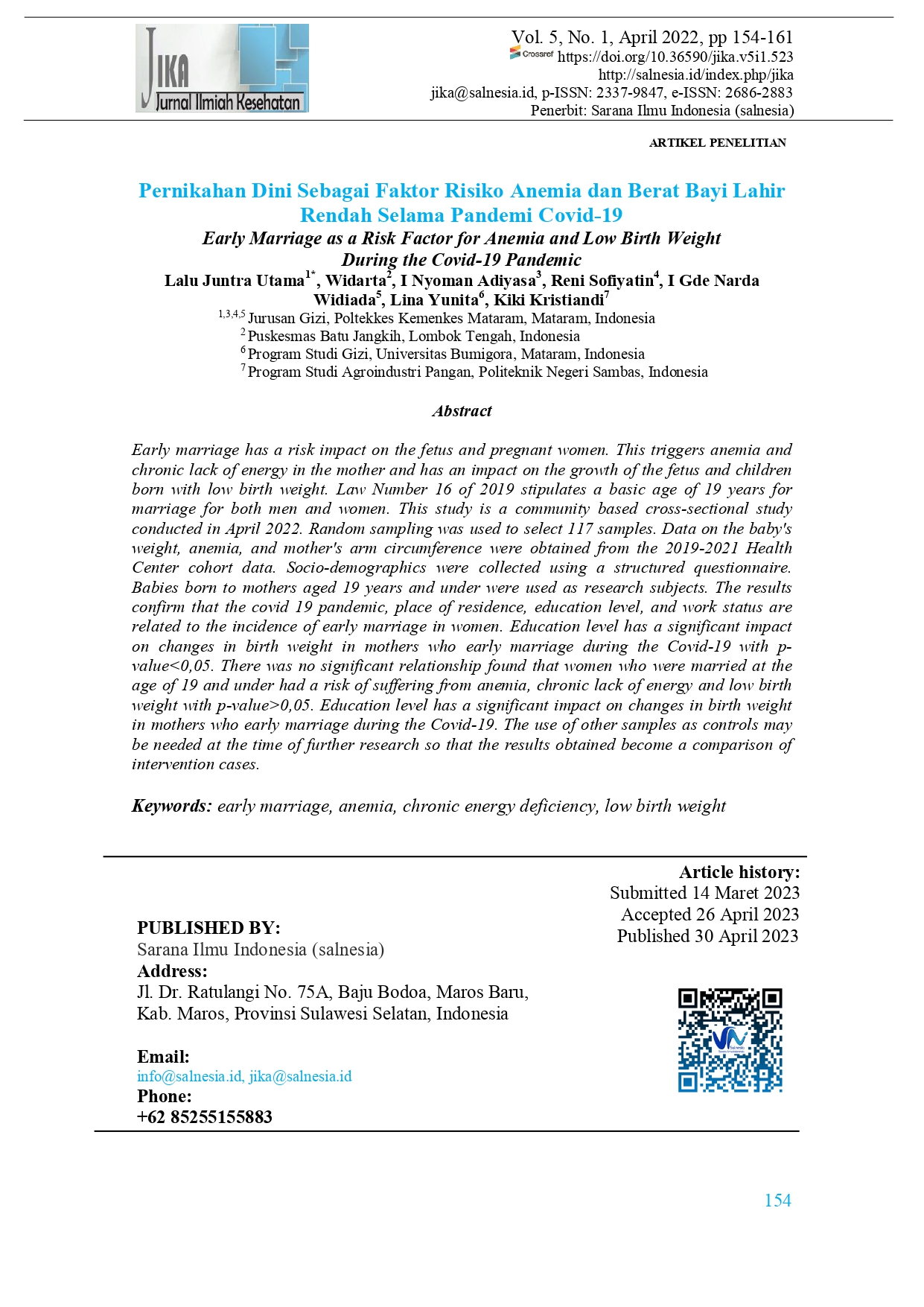Early Marriage as a Risk Factor for Anemia and Low Birth Weight During the Covid-19 Pandemic
DOI:
https://doi.org/10.36590/jika.v5i1.523Keywords:
early marriage, anemia, chronic energy deficiency, low birth weightAbstract
Early marriage has a risk impact on the fetus and pregnant women. This triggers anemia and chronic lack of energy in the mother and has an impact on the growth of the fetus and children born with low birth weight. Law Number 16 of 2019 stipulates a basic age of 19 years for marriage for both men and women. This study is a community based cross-sectional study conducted in April 2022. Random sampling was used to select 117 samples. Data on the baby's weight, anemia, and mother's arm circumference were obtained from the 2019-2021 Health Center cohort data. Socio-demographics were collected using a structured questionnaire. Babies born to mothers aged 19 years and under were used as research subjects. The results confirm that the covid 19 pandemic, place of residence, education level, and work status are related to the incidence of early marriage in women. Education level has a significant impact on changes in birth weight in mothers who early marriage during the Covid-19 with p-value<0,05. There was no significant relationship found that women who were married at the age of 19 and under had a risk of suffering from anemia, chronic lack of energy and low birth weight with p-value>0,05. Education level has a significant impact on changes in birth weight in mothers who early marriage during the Covid-19. The use of other samples as controls may be needed at the time of further research so that the results obtained become a comparison of intervention cases.
Downloads
References
Abate MG, Tareke AA. 2019. Individual and community level associates of contraceptive use in Ethiopia: a multilevel mixed effects analysis. Arch Public Health, 77(1). https://doi.org/https://doi.org/10.1186/s13690-019-0371-z.
Abdillah I, Ahsan, J, Kumar A, Shariff A, Sinaga M, Malik, T. 2018. Socio-economic factors influence iron-folic acid supplementation during pregnancy compliance with who guideline in Eastern Ethiopia. IJCRT, 6(1).
Assefa N, Berhane Y, Worku A. 2012. Wealth Status, Mid Upper Arm Circumference (MUAC) and Antenatal Care (ANC) are Determinants for Low Birth Weight in Kersa, Ethiopia. PLoS One, 7(6).
BPS [Badan Pusat Statistik]. 2020. Survei Demografi dan Kesehatan Indonesia (SDKI) tahun 2017 (Indonesia Demographic and Health Survey (IDHS)). Jakarta: BPS.
Chen MH, Su T-P, Chen YS, Hsu JW, Huang KL, Chang WH, et al. 2013. Association between psychiatric disorders and iron deficiency anemia among children and adolescents: a nationwide population-based study. BMC Psychiatry, 13(16).
Dinkes Provinsi Nusa Tenggara Barat [Dinas Kesehatan Provinsi Nusa Tenggara Barat]. 2021. Profil Kesehatan Tahun 2021. Mataram: Pusat Data dan informasi.
Dinas P3A NTB. 2020. Data Pernikahan Anak di Bawah Umur di Provinsi Nusa Tenggara Barat Tahun 2020. Mataram: DP3A NTB.
Dinkes Kabupaten Lombok Tengah [Dinas Kesehatan Kabupaten Lombok Tengah]. 2021. Profil Kesehatan Tahun 2021. Kabupaten Lombok Tengah: Pusat Data dan informasi.
Ethiopia FDR. 2020. National Nutrition Program II, 2016–2020. Addis Ababa, Ethiopia.
Fage SG, Egata G, Dessie Y, Kumsa FA, MB. 2020. Anemia among school adolescents in Haramaya town, eastern Ethiopia: cross-sectional study. Nutri Metabolic Insights, 13:1–6.
Gebremedhin S, Samuel A, Mamo G, Moges T, AT. 2014. Coverage, compliance and factors associated with utilization of iron supplementation during pregnancy in eight rural districts of Ethiopia: a cross-sectional study. BMC Public Health, 14(1): 607. https://doi.org/https://doi.org/10.1186/1471-2458-14- 607.
Kemenkes [Kementrian Kesehatan]. 2020. Profil Kesehatan Indonesia Tahun 2020. Jakarta: Pusat Data dan informasi Kementerian Kesehatan Republik Indonesia..
Paul P. 2019. Child Marriage and Its Association with Morbidity and Mortality of Children Under 5 Years Old: Evidence from India. Journal of Public Health: From Theory to Practice, 28: 331–338. https://doi.org/https://doi.org/10.1007/s10389-019- 01038-8.
Rah. 2013. Adolesent pregnancy, its impact on the growth and nutritional status of young mothers: what does evidence say. Sight Life, 27: 37–48.
Rahfiludin MZ, Dharmawan Y. 2018. Risk Factors Associated with Low Birth Weight. Kesmas: National Public Health Journal, 13(2): 75–80. https://doi.org/http://dx.doi.org/10.21109/kesmas.v13i2.17 19.
Riu D, Mappaware N, Asmi M, TA. 2020. Maternal hemoglobin concentration and birth weight: a report from mother and child tertiary hospital. Enfermería Clínica, 30: 92–95. https://doi.org/https://doi.org/10.1016/j.enfcli.2019.07.042.
Tiruneh FN, Chuang K-Y, CY-C. 2018. Women’s autonomy and maternal healthcare service utilization in Ethiopia. BMC Health Serv Res, 17(1): 718. https://doi.org/https://doi.org/10.1186/s12913-017-2670-9.
Tura MR, Egata G, Fage SG, RK. 2020. Prevalence of Anemia and its associated factors among female adolescents in ambo town, west Shewa, Ethiopia. J Blood Med, 11: 279–287. Available at: https://doi.org/https://doi.org/10.2147/JBM.S263327.
WHO [World Health Organization]. 2011. Haemoglobin concentrations for the diagnosis of anaemia and assessment of severity. Geneva: WHO.
Yadav DK, Chaudhary U. Shrestha N. 2011. Risk Factors Associated with Low Birth Weight. Journal of Nepal Health Research Council, 9(19): 159–164.

Downloads
Published
How to Cite
Issue
Section
License
Copyright (c) 2023 Lalu Juntra Utama, Widarta, I Nyoman Adiyasa, Reni Sofiyatin, I Gde Narda Widiada, Lina Yunita, Kiki Kristiandi

This work is licensed under a Creative Commons Attribution 4.0 International License.








